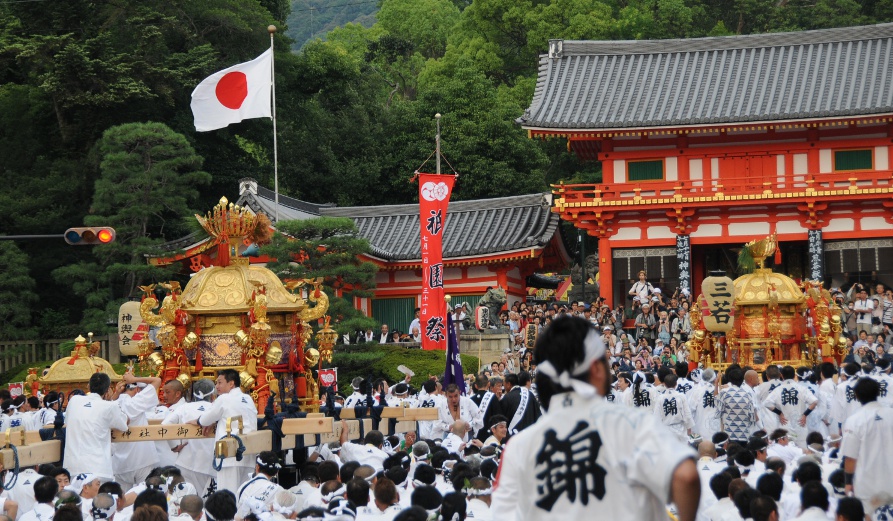Yesterday was the last of the three big festivals in Kyoto, Jidai matsuri (the other two are Aoi and Gion matsuri). Literally the name translates as Period Festival, but it is better known in English as the Festival of the Ages, and that although it has a history of rather short 120 years only. The first Jidai matsuri took place in 1895, 1100 years after Kyoto had become the capital of Japan, and only a few years after it had lost that place to Tokyo when the emperor moved his household there. Jidai matsuri is – like most of the festivals in Japan – connected to a shrine, and in this case it is Heian shrine (named after the old name of Kyoto: Heian-kyo) , which is a 2/3 scale replica of the former imperial palace, was built also in 1895, and enshrines the first (Kanmu) and the last emperor (Komei) that had Kyoto as residence.
The first Jidai matsuri took place in 1895, 1100 years after Kyoto had become the capital of Japan, and only a few years after it had lost that place to Tokyo when the emperor moved his household there. Jidai matsuri is – like most of the festivals in Japan – connected to a shrine, and in this case it is Heian shrine (named after the old name of Kyoto: Heian-kyo) , which is a 2/3 scale replica of the former imperial palace, was built also in 1895, and enshrines the first (Kanmu) and the last emperor (Komei) that had Kyoto as residence.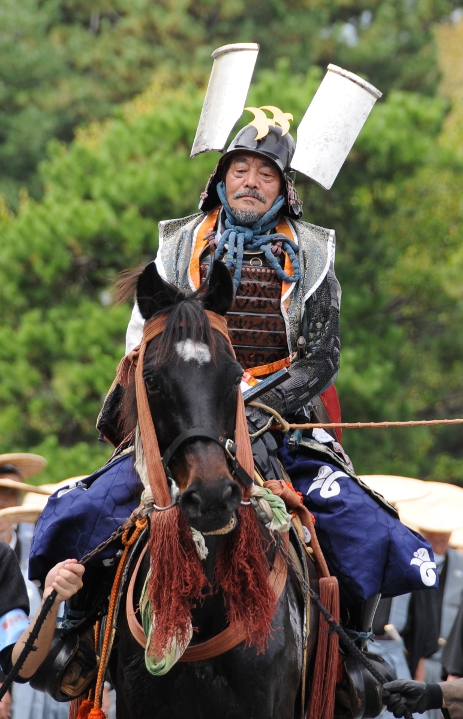 The idea behind Jidai matsuri is to showcase not only Kyoto’s history, but that of all Japan, and this is done with a long costume procession “back in time” from the Meiji era through the long Edo period of peace until the famous Heian era. About 2000 people form the procession, wearing traditional clothing, not only the well known ones of famous samurai going to war or court ladies of leisure, no, also normal people in their work clothing and straw sandals, are walking the streets of Kyoto from the imperial palace to Heian shrine.
The idea behind Jidai matsuri is to showcase not only Kyoto’s history, but that of all Japan, and this is done with a long costume procession “back in time” from the Meiji era through the long Edo period of peace until the famous Heian era. About 2000 people form the procession, wearing traditional clothing, not only the well known ones of famous samurai going to war or court ladies of leisure, no, also normal people in their work clothing and straw sandals, are walking the streets of Kyoto from the imperial palace to Heian shrine.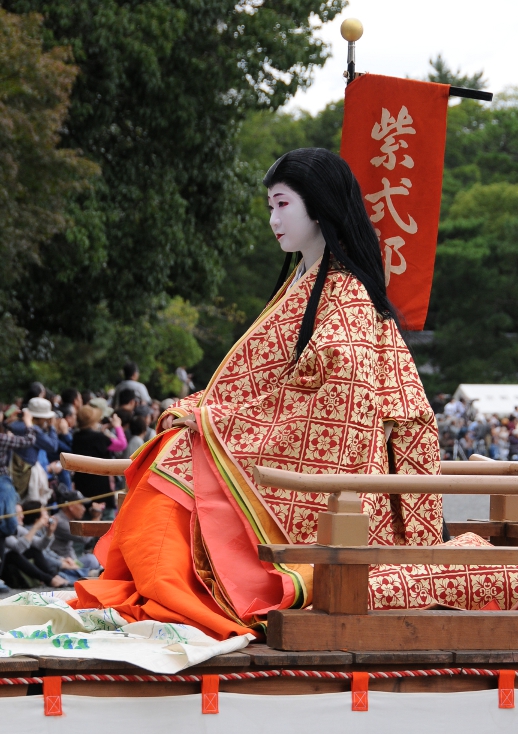 Of course, there are additional props that can’t be missing: samurai on horses accompanied by stable boys and soldiers on foot with weapons ranging from the long rifles of the Meiji era to the swords of the earlier periods. Court ladies in lavish kimono comprised of several layers were carried along on platforms or walk underneath large umbrellas. People carrying flowers or offerings for the shrine followed two mikoshi that held the spirits of the two emperors mentioned above, and a large wagon with undetermined contents was drawn by a black ox. And in between, large groups of people were playing music – on seemingly modern flutes and drums at first, then on instruments that I have only seen during religious ceremonies, and finally there was a lone soldier blowing on a horn made from a large shell.
Of course, there are additional props that can’t be missing: samurai on horses accompanied by stable boys and soldiers on foot with weapons ranging from the long rifles of the Meiji era to the swords of the earlier periods. Court ladies in lavish kimono comprised of several layers were carried along on platforms or walk underneath large umbrellas. People carrying flowers or offerings for the shrine followed two mikoshi that held the spirits of the two emperors mentioned above, and a large wagon with undetermined contents was drawn by a black ox. And in between, large groups of people were playing music – on seemingly modern flutes and drums at first, then on instruments that I have only seen during religious ceremonies, and finally there was a lone soldier blowing on a horn made from a large shell.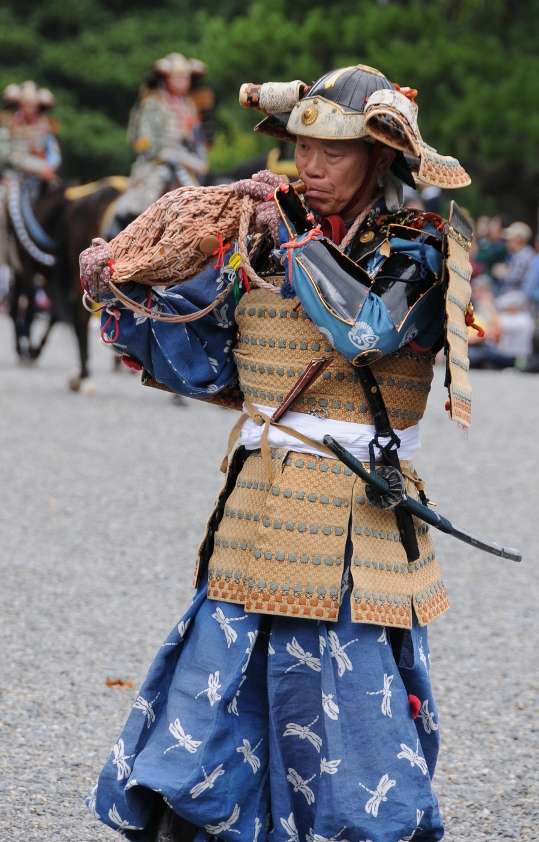 There is an enormous amount of attention paid to every detail of every costume: from the appropriate hairstyle (sometimes accomplished using wigs) to the clothing itself (some of the samurai wore loudly clanging heavy armour) and all the accessories (helmets, jewelry, war fans and weapons, ladles and buckets to water the horses) down to the footwear – boots and sandals made from rice straw. It is a real joy to watch, and it takes – nomen est omen – ages until the procession passes by any one point – more than two hours altogether.
There is an enormous amount of attention paid to every detail of every costume: from the appropriate hairstyle (sometimes accomplished using wigs) to the clothing itself (some of the samurai wore loudly clanging heavy armour) and all the accessories (helmets, jewelry, war fans and weapons, ladles and buckets to water the horses) down to the footwear – boots and sandals made from rice straw. It is a real joy to watch, and it takes – nomen est omen – ages until the procession passes by any one point – more than two hours altogether.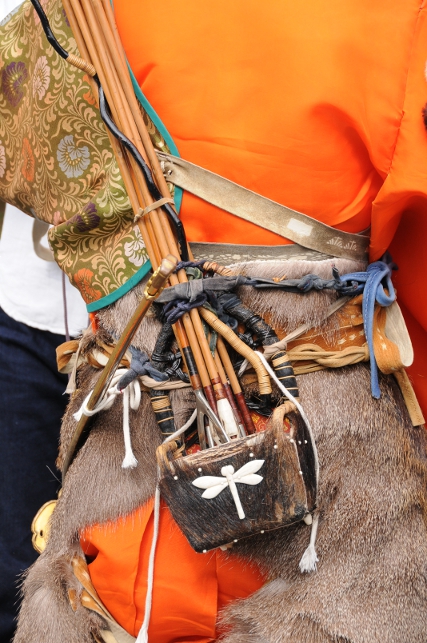 What I found most exciting though was that the participants of the procession gathered on the pathways of the imperial gardens before the start, so you can watch the participants getting dressed, having lunch, or posing for pictures – some of them even selfies 😉 This was different from the Aoi festival in May where the procession started from within the palace and the participants were not seen before. Somehow the fact that they were just gathering “in the open” so to speak, gave me the feeling of a rather relaxed, fun thing – as opposed to Aoi – but maybe that’s because Aoi is more of a religious ritual than Jidai matsuri?
What I found most exciting though was that the participants of the procession gathered on the pathways of the imperial gardens before the start, so you can watch the participants getting dressed, having lunch, or posing for pictures – some of them even selfies 😉 This was different from the Aoi festival in May where the procession started from within the palace and the participants were not seen before. Somehow the fact that they were just gathering “in the open” so to speak, gave me the feeling of a rather relaxed, fun thing – as opposed to Aoi – but maybe that’s because Aoi is more of a religious ritual than Jidai matsuri?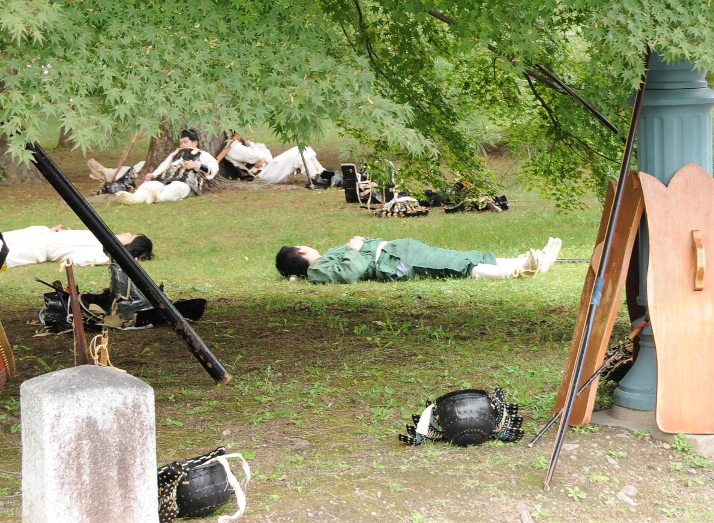
Category: Kyoto Special
Nijo Castle
One of my favourite places in Kyoto is Nijo-jo, the state residence of the Tokugawa shoguns of the Edo period. It is situated pretty much in the centre of Kyoto, southeast of the emperor’s palace, on Nijo-oji dori. It has been started on orders of the first shogun, Tokugawa Ieyasu, in 1601, but was completed only in 1626, under Ieyasu’s grandson, the third shogun.
The whole complex of Nijo-jo comprises 275.000 square metres inside a wide moat, but only 8000 square metres are built upon. There are actually two castles on the ground, the inner citadel called Honmaru is surrounded by a moat, and on the grounds outside of it, in the eastern gardens lies the actual residence of the shogun, Ninomaru, the second citadel. The Tokugawa shoguns actually resided in Edo, today’s Tokyo (hence the name Edo-period), but still they needed to show their wealth and influence in Kyoto where the emperor resided as well, lest the people would forget who’s actually ruling the country. All of Nijo castle is built from wood, and despite it having burnt down and been rebuilt just to be damaged by typhoons, it is still a highly impressive site.
 When the first moat is crossed, you enter Ninomaru palace through the Kara-mon gate. Ninomaru was designated as the residence of the shoguns (should they ever want to stay in Kyoto) and it is comprised of five buildings, all connected with corridors. As a visitor to the shogun, your entrance would be closely watched, and how far you would get inside the buildings would be determined by your rank – in Japan even then hierarchy was everything. You would start out by entering the retainer’s waiting rooms tozamurai-no-ma, go further to the formal reception room shikidai-no-ma and from there move on to the grand rooms ohiro-ma. Only very important people, for example messengers from the emperor would be allowed further into the inner audience chambers kuro-shoin.
When the first moat is crossed, you enter Ninomaru palace through the Kara-mon gate. Ninomaru was designated as the residence of the shoguns (should they ever want to stay in Kyoto) and it is comprised of five buildings, all connected with corridors. As a visitor to the shogun, your entrance would be closely watched, and how far you would get inside the buildings would be determined by your rank – in Japan even then hierarchy was everything. You would start out by entering the retainer’s waiting rooms tozamurai-no-ma, go further to the formal reception room shikidai-no-ma and from there move on to the grand rooms ohiro-ma. Only very important people, for example messengers from the emperor would be allowed further into the inner audience chambers kuro-shoin.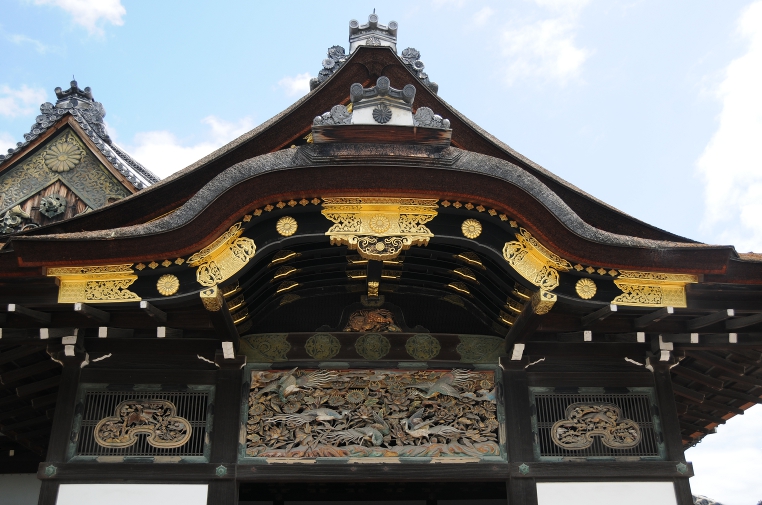 The total floor space of Ninomaru palace measures 3300 square metres, divided into corridors and 33 rooms covered by more than 800 tatami mats. Each of the large rooms are divided into smaller rooms by sliding doors, and the rooms are named after the paintings on those doors. All of them are lavishly decorated with gold and exquisite paintings of plants, trees, or animals, and on top of the doors there are intricate wood carvings, often looking different depending from which side of the doors you look at them. At the end of all the long corridors there are the shogun’s living quarters, the shiro-shoin. They are relatively modest in size, compared to the rest of the palace, and only female servants were allowed to enter there, obviously for safety reasons.
The total floor space of Ninomaru palace measures 3300 square metres, divided into corridors and 33 rooms covered by more than 800 tatami mats. Each of the large rooms are divided into smaller rooms by sliding doors, and the rooms are named after the paintings on those doors. All of them are lavishly decorated with gold and exquisite paintings of plants, trees, or animals, and on top of the doors there are intricate wood carvings, often looking different depending from which side of the doors you look at them. At the end of all the long corridors there are the shogun’s living quarters, the shiro-shoin. They are relatively modest in size, compared to the rest of the palace, and only female servants were allowed to enter there, obviously for safety reasons.
Many more measures were taken to ensure the safety of Japan’s ruler. For example, in some of the rooms where the shogun would be present himself, there are doors behind which armed men would wait for the faintest sign of distress to enter and protect their master. Many castles have these, and the doors are usually well disguised. Not so in Ninomaru though – the shogun did obviously not buy into the idea of discreet hinting – here those doors are well visible, and even decorated with big red tassels. The most interesting protective features of Ninomaru palace however, are its corridors. They are made of plain wood, but the boards are placed on nails in a special way such that each person walking on them causes the construction to chirp like birds – hence the name uguisubari – nightingale floors. Walking on them is quite some fun, not only for school kids, and the idea was to prevent intruders from sneaking up the corridors and launching a surprise attack.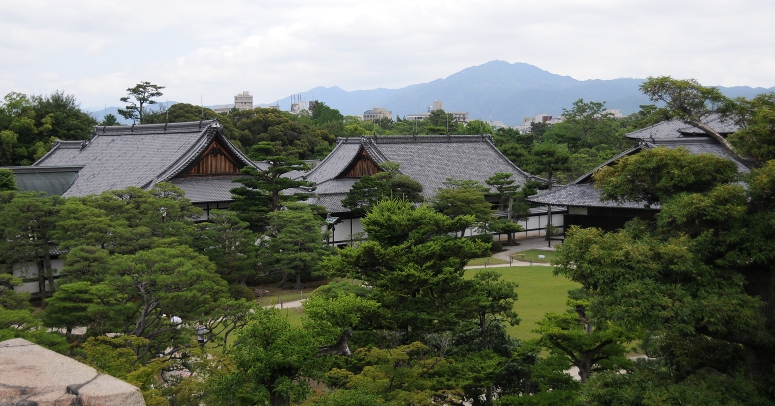 Crossing the second moat leads you to Honmaru palace. This part of Nijo castle measures 16800 square metres, and it was once the home of a palace similar to Ninomaru and also sported a large five-story castle. However, both buildings were destroyed by fire in the 18th century already, and there has been no attempt to rebuild them. The present Honmaru building once stood on the grounds of the imperial gardens and was moved here at the end of the 19th century. It is not generally accessible, so I cannot say anything about its interior.
Crossing the second moat leads you to Honmaru palace. This part of Nijo castle measures 16800 square metres, and it was once the home of a palace similar to Ninomaru and also sported a large five-story castle. However, both buildings were destroyed by fire in the 18th century already, and there has been no attempt to rebuild them. The present Honmaru building once stood on the grounds of the imperial gardens and was moved here at the end of the 19th century. It is not generally accessible, so I cannot say anything about its interior.
The buildings are surrounded by beautiful Japanese gardens, three different ones stemming from three different periods: Ninomaru garden is the oldest, as it was constructed during the Edo period. Honmaru garden is the middle one, built in the Meiji period at the end of the 19th century, and the so called Seiryu-en garden is the youngest, having been constructed only in 1965.
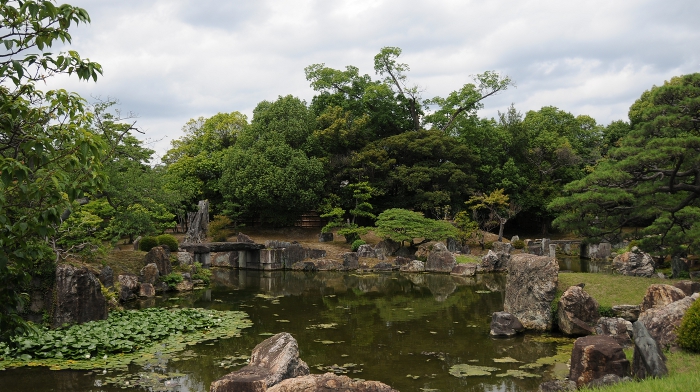 As I said, Nijo castle is beautiful, if you come to Kyoto, it is one of the places you must not miss! Nijo-jo is now a property of Kyoto city and has been open to the public since 1940; in 1994 it has been designated by the UNESCO as World Heritage Site. Unfortunately, because the paintings in Ninomaru are 400 years old, it is not allowed to take any pictures there. A few photos can be found on the official Kyoto city website for Nijo castle though.
As I said, Nijo castle is beautiful, if you come to Kyoto, it is one of the places you must not miss! Nijo-jo is now a property of Kyoto city and has been open to the public since 1940; in 1994 it has been designated by the UNESCO as World Heritage Site. Unfortunately, because the paintings in Ninomaru are 400 years old, it is not allowed to take any pictures there. A few photos can be found on the official Kyoto city website for Nijo castle though.
White Night
Kyoto has 10 sister cities, and one of them is Paris. The idea behind sister cities is to foster cultural exchange, so, last Saturday there was La Nuit Blanche, the white night in Kyoto. For the third year already, there were exhibitions, performances and meetings of French and Japanese artists throughout the city of Kyoto – and Paris as well. The opening ceremony, starting at 7 pm. with the French minister of culture, took place at the Kyoto Manga Museum (of all places), then there was a projection of art onto Kyoto City Hall, and then there were many small events in art galleries and other places around the city. 
I have to admit that I’m not very big on modern or performing arts – although I like photography and sculpture and make the occasional trip to see opera. Anyway, I decided to check out the white night regardless, and there happened to be an interesting performance in a house near Ebisu’s.
I arrived at the house – old Japanese style with a beautiful garden – shortly before one show, and as we were led through the house in a roundabout way to the stage, we had to pass through white woollen threads hanging from the ceiling or having been woven into something resembling spider’s webs. We took seats at the edge of a darkened room furnished only with tatami; there were more threads hanging from the ceiling, and in the middle of the room something lay, covered with a black cloth.
All of a sudden, music started, spotlights came on, and the “thing” began to move. There turned out to be a woman underneath the black sheet, dressed in white, with straight black hair and white makeup (like the one geisha wear) on face and arms, who was “chained” to the ceiling with the wool. She began to move more vigorously, finally broke her chains and disappeared though a side door. The whole performance took less than 10 minutes. As I said I am not very big on modern art, and this one made me shiver… All the time I had the feeling the creature was evil and rightfully in chains, and when she had escaped, that something very dangerous was now at large.
My housemate later explained that this was a special type of Japanese performing art, that it originated some time after the war and that it is centred on depicting primeval forces and on evoking feelings of fear in the spectators. It certainly did that for me, and probably for the Japanese spectators as well, as they were leaving very quietly, nobody clapped or gave any sign of appreciation of the actress. It was interesting, but more interesting it would be to find out why the Japanese are all so fond of ghost stories…
Flea Market
Every month on the 25th, the big flea market at Kitano Tenman-gu shrine takes place. As I wanted to look for something particular, and the weather was just perfect today, I went there in the morning.
Kitano Tenman-gu’s market is a typical flea market. From the first torii gate back to the shrine buildings there are food stalls, toys and games for kids, and also newly made handicraft. You can also buy fruits and veggies there, and one part is dedicated to flowers, plants, bushes – and bonsai. In the eastern part of the grounds, however, there is the “real” flea market, where people sell things second hand. You can buy anything from porcelain to brass ornaments, from pipes to watches, from swords to WW II memorabilia, from hand painted scrolls to jewellery. 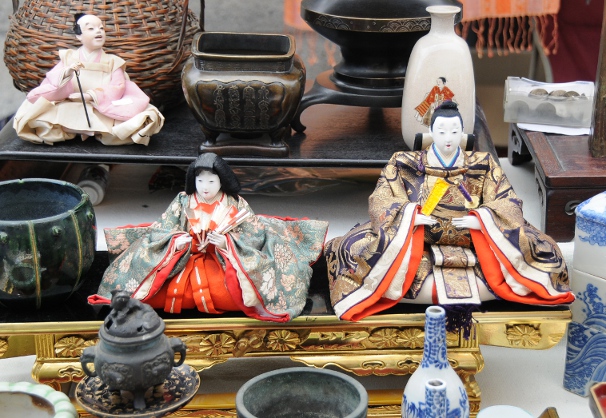
And kimono. Hundreds, if not thousands of them. There is a huge variety for both women and men, starting from the most basic, unlined summer yukata to the very elaborately embroidered wedding kimono. Many of the stalls have a fixed price of 1000 YEN per piece, but some special kimono can be more expensive. Other stalls sell the necessary accessories, like sandals and socks, and it should be possible to buy a full summer outfit for less than 10.000 YEN. Of course, whether the fashion conscious Japanese can tell that you are wearing a possibly out of fashion kimono, I do not know…
Anyway, I went to the flea market to buy a soroban for my class. Most of the ones I saw however, were the old, pre WW II ones, with five ichi-dama at the bottom instead of the modern four. While they are beautiful, made of heavy wood and often in very good condition, I wanted to buy one I can actually use. And, wouldn’t you believe it – I got very lucky indeed as I spotted a current model with 27 rods for only 500 YEN – about one tenth of the price of a new one! It still bears the name of the previous owner, but that’s not a problem, as it has to be cleaned anyway… I am very happy about my purchase.
Kitano Tenman-gu’s flea market is probably the biggest one in Kyoto, but there are many others at shrines and temples throughout the city and throughout each month. The dates are fixed, rain or shine, and most are from early in the morning to late afternoon at 4 or 5 pm. Here is an incomplete list of the Kyoto flea markets I know:
1st: To-ji temple
8th: Toyokuni shrine
15th: Chion-ji temple
21st: To-ji temple
22st: Kamigamo shrine
25th: Kitano Tenman-gu
Equinox
Today was a public holiday in Japan, the Autumnal Equinox Day or Shubun no Hi. Nowadays the idea is to say thank you for the harvest, a sort of thanksgiving. The holiday is a modernized version of what was called Shu Ki Koreisai, a day to pay respects to past emperors and the imperial family in general, introduced in 1878. And this day in turn probably goes back to ancestor worship in China. Note that the spring equinox is also a national holiday in Japan, with the same idea behind it.
When I was finished with my daily Japanese lesson today, I betook myself to a very small local matsuri in Omiya street, near the crossing with Imadegawa. It is in the old district of the weavers and cloth makers, and you could go into some of the old merchant’s houses and have a look. They are beautifully restored and many old pieces of furniture were on display, together with some of the traditional tools they were using. The houses had a room or two in front that once featured as a shop, then there was a small Japanese garden, and a narrow corridor next to it would lead to the private rooms at the back.
In several houses beautiful kimono were on display, and in one of them, I could watch a kimono painter at work. He was a man of at most 60 years, working in what is called the yuzen dying technique, and he explained that each of his kimonos consisted of 30 meters of silk (strips about 40-50 centimetres wide) and that one hand painted kimono needed 15 different steps of handiwork until its completion. Apparently the price for his garments is reasonable, considered that all of the work is done by hand, but I did not dare ask for a number. Unfortunately he did not answer my question as to how many hours of work one such kimono would need. It seems however, that the demand for this type of work is steadily on the decline, first because people don’t wear kimono anymore, and if they do for a special occasion here or there, the price is probably prohibitive in any case.
Yugoya
 Yesterday was full moon, and this particular one on August 15th in the lunar calendar, the harvest full moon, is said to be the brightest and most beautiful of them all, and this fact drives many Japanese out to moon viewing parties. There were numerous yugoya events throughout Kyoto last night, some of them with green tea being offered, koto-recitals, or similar. However, we chose to go to Daikakuji and its pond as it is considered the best spot for yugoya. The area around the temple is still rather rural – I walked through rice fields on my way there – and the city forbids development, so the nights are dark and quiet, just perfect for moon viewing.
Yesterday was full moon, and this particular one on August 15th in the lunar calendar, the harvest full moon, is said to be the brightest and most beautiful of them all, and this fact drives many Japanese out to moon viewing parties. There were numerous yugoya events throughout Kyoto last night, some of them with green tea being offered, koto-recitals, or similar. However, we chose to go to Daikakuji and its pond as it is considered the best spot for yugoya. The area around the temple is still rather rural – I walked through rice fields on my way there – and the city forbids development, so the nights are dark and quiet, just perfect for moon viewing.
Daikakuji is one of the big Buddhist temples in Arashiyama, the westernmost part of Kyoto. It was built as detached palace for emperor Saga, and in 876 he designated it to be converted into a Shingon Buddhist temple. The origin as palace is still palpable throughout the compound: beautiful gardens lie between spacious buildings which are lavishly decorated and have amazing paintings on their sliding doors. A large part of the buildings can be visited, and yesterday at dusk, especially the old gardens made a deep impression on me. Then there is Osawa, a large lotus pond, next to the temple, which was specially laid out to resemble lake Tungting in China.
And this pond is what draws people to Daikakuji for the yugoya: Large boats cruise the pond, quietly pushed with bamboo poles, and a ride on one of those, away from the noisy people on shore, with lots of time to contemplate the moon, must indeed be quite an experience. Unfortunately, an experience we were not able to make, because by the time we arrived at the temple, all boats were sold out already.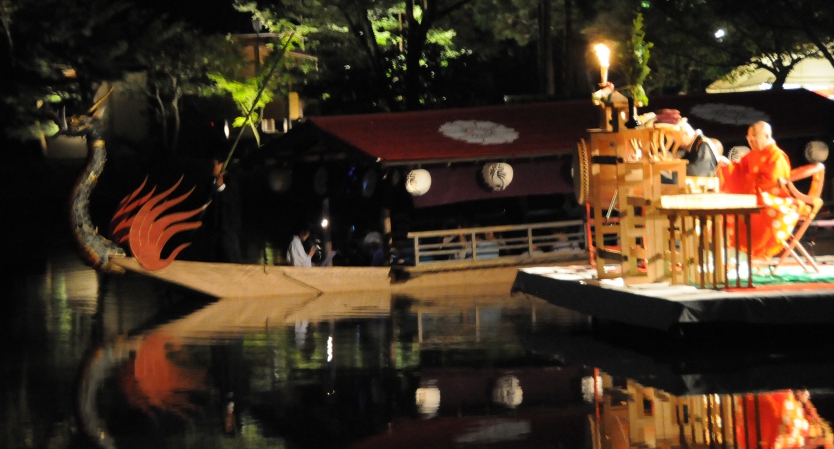
Anyway, we took our time to see the palace/temple and at 6:30 a ceremony started with a long procession of priests taking their place on a platform prepared in the lake, the altar in the direction of the full moon, which had already risen by that time, and did look very beautiful indeed on the cloudless sky. It was an interesting mix of Shinto and Buddhist rites, with shrine maidens and Buddhist priests, something I have never encountered before. There were drums and cymbals, and the ceremony ended with a reading (or rather: chanting) from one of the Buddhist main texts.
Afterwards, we turned our attention to the food stalls on the shore: Takoyaki, udon and soba, traditional Kyoto style mochi called yatsuhashi and slightly modernized ones with strawberry filling, beer, soft drinks and shaved ice… But of course, special days call for special treats. For example, there are round white mochi with a strip of anko – red bean paste – across them, meant to resemble the moon behind a cloud. More appealing to me, however – remember that I don’t really like anko – were the little sweets in shape of white rabbits. Rabbits? Well, according to Asian tradition, there is a rabbit living in the moon…
Lights
As I have mentioned on Monday, from August 14th through 16th the Festival of the Dead, or Obon, is celebrated in the Kansai region of Japan. The idea is that the ancestors of each family come back from the realm of the Dead to visit their offspring, are worshipped and treated to some goodies, and then are sent off again.
How this is celebrated depends on the region, but very often it has something to do with fire and light to guard the spirits. For example, I have seen in a comparatively small town in Nagano province, where many people own a house with garden, that during Obon small fires are lit at the entrance of each house so the spirits can find their way home easily. Here in Kyoto, at the Higashi Otani Cemetery for example, lamps with real candles are lit at the huge graveyard, and people can come and worship their ancestors during the early evening, bringing flowers and little offerings – I have even seen a cup of sake here and there.
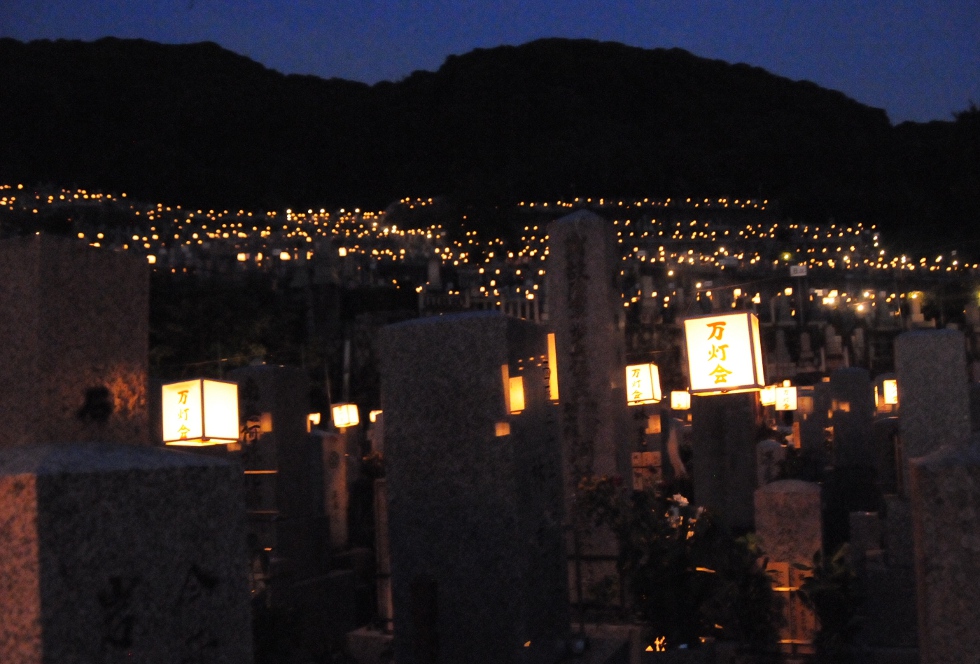 The important part of Obon however, is to make sure that the ghosts don’t linger for too long. They are sent off – once more with fire and lights – on August 16th. Again, the ceremony depends on the region. Where there is a prominent river or lake or maybe even the sea, little paper lanterns are inscribed with the name of the dead person and then set afloat on the water, so the spirit goes, accompanied by the light of the candle, home to the ocean.
The important part of Obon however, is to make sure that the ghosts don’t linger for too long. They are sent off – once more with fire and lights – on August 16th. Again, the ceremony depends on the region. Where there is a prominent river or lake or maybe even the sea, little paper lanterns are inscribed with the name of the dead person and then set afloat on the water, so the spirit goes, accompanied by the light of the candle, home to the ocean.
One of the most spectacular ways of sending off the spirits is happening in Kyoto (where else). It is called the Gosan-no-Okuribi (literally the Five Mountains Send Off Fire) or more simply the Daimonji. Kyoto has mountains on three of its sides, and on the flanks of the northern ones (counterclockwise from east to west) five huge bonfires are lit at 8 pm on August 16th. Each bonfire has a specific shape: The first one (the daimonji) is the kanji for “big”, the second one (myo and ho) the kanji for the Buddhist concept of “dharma”. The third one (funagata) has the shape of a boat the souls can ride in, the fourth one is another “big” kanji (called the left one to distinguish it from the first), and the last one is in the shape of a shrine gate or “torii”. The fires are lit at intervals of 5 to 10 minutes and only last for about 20 minutes, to keep it sweet and short.
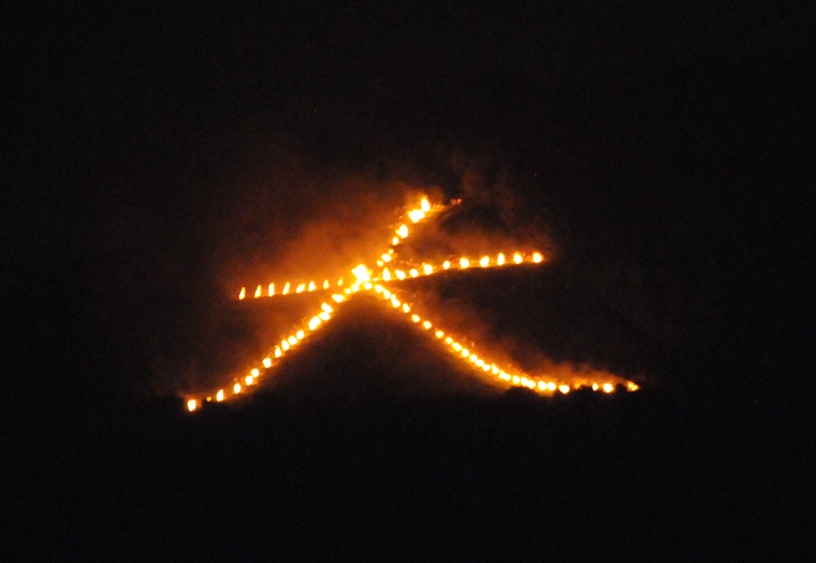 The worshipping of the ancestors at the cemetery, including light and fire rituals of one sort or the other, is done all over Japan, and of course it is necessary to travel home for that. Hence, although Obon is not a national holiday, many small and family run businesses close and allow their employees a few days to go home. This makes travelling during Obon very stressful, as there are so many people abroad, but interestingly, it is relatively easy to find a hotel (unless you insist on something small and family-owned) – clearly everybody stays with family.
The worshipping of the ancestors at the cemetery, including light and fire rituals of one sort or the other, is done all over Japan, and of course it is necessary to travel home for that. Hence, although Obon is not a national holiday, many small and family run businesses close and allow their employees a few days to go home. This makes travelling during Obon very stressful, as there are so many people abroad, but interestingly, it is relatively easy to find a hotel (unless you insist on something small and family-owned) – clearly everybody stays with family.
I will write a bit more about Obon in my post tomorrow.
Gion Matsuri, Part III
Last Wednesday the last main event of Gion matsuri took place – the Kanko Sai festival, where the three mikoshi were taken from their temporary display on the Otabisho, carried on different routes through the inner city, and then returned to Yasaka shrine.
The parade started at 5 pm at the Otabisho. All of the things that can be seen in the picture of Wednesday’s post were removed and the mikoshi stood there for easy removal. The first one to be removed was the centre one. First there was a blessing of both the mikoshi and its bearers in front of the shrine to the right of the Otabisho. The mikoshi was then fixed to two long wooden beams and, amid shouts and clapping, was carried through the narrow streets of the inner city.
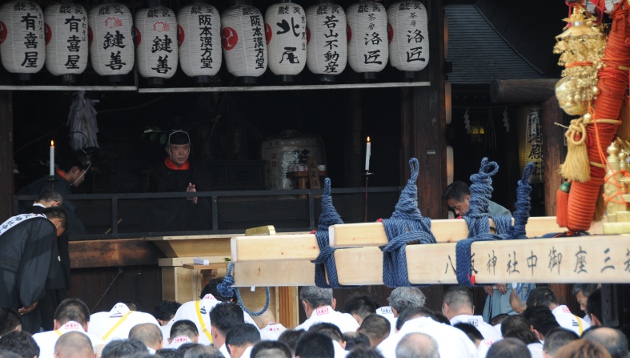
The same was done with the other mikoshi, first the “west” one, and finally the “east” one. One of them was carried through the narrow streets of Teramachi, and then through Nishiki food market, and I am still amazed how its bearers could manage to make the very narrow 90 degree turn between the two streets… Each mikoshi was accompanied by a person on a horse – the centre one by the chigo, by the way – and finally, around 9 pm, the individual parades turned towards Yasaka shrine, lead by a procession that carried all the things that were removed from the shrine to accompany the gods in the first place.

Once again, the bearers of the mikoshi showed off their strength by turning it around on its long wooden beams whenever possible, always accompanied by a rhythmic shouting of “hoi-tto”, “hoi-sso” or “ri-ssa”, and at Yasaka shrine itself each mikoshi was carried three times around the centre stage before it was placed in there again. The men carrying the mikoshi must have been exhausted at the end, but there was a certain excitement that went through them and the spectators, although I have seen a few with blood stains on their shoulders…
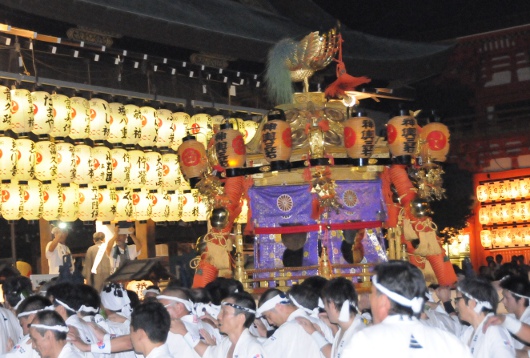
All of this took a very long time, partly also because of the fastening and unfastening of the heavy ropes that were used to tie the mikoshi to several wooden beams. Finally, around 11:30, all mikoshi had been placed again on the stage at the centre of Yasaka shrine. Then, all the lights were turned off and only the moon lit the final, most important scene: the return of the gods to the main shrine. A path was made with sacred rope between the centre stage and the main shrine building. Accompanied by music and hidden from view by screens, two priests went from the main shrine to the centre stage and at each mikoshi in turn either perfomed a rite or actually removed something they then brought back to the main building to enshrine there again.
Except for the music, it was quiet, the hundreds of remaining spectators were completely still, many of them had folded their hands in prayer. A palpable relief went through the crowd when the gods were returned to their proper home and the lights were turned on again. Many people then went to the shrine and offered a quick prayer. The scene was strangely touching, even though I am not religious.
It was midnight by then and I had to walk home. About 5 minutes after the gods had returned home, it started to rain. Well, the main part of Gion matsuri was over anyway.
Rain
Today is the last major event of Gion matsuri. The three mikoshi which have been transferred from Yasaka shrine to their temporary abode in the Otabisho in the city centre will be moved back to the shrine today. 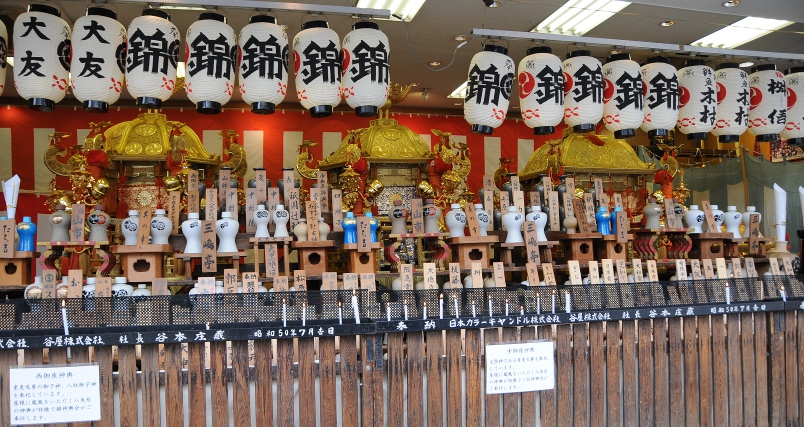 The ceremony starts with the procession of the mikoshi through the inner city at 17:00 and will end at Yasaka shrine around midnight. It was raining in the morning but hopefully it will clear up until the evening… I shall report on Saturday again.
The ceremony starts with the procession of the mikoshi through the inner city at 17:00 and will end at Yasaka shrine around midnight. It was raining in the morning but hopefully it will clear up until the evening… I shall report on Saturday again.
Gion Matsuri, Part II
Last Wednesday, July 17th, the festivities of Gion matsuri reached their peak. In the morning, there was the Yama Hoko Junko parade through the inner city, and in the early evening the three deities of Yasaka shrine were moved to their temporary residence at the Otabisho.
The procession in the morning was beautiful. In total, there are 32 floats, nine of them called hoko and the others yama. Both types date back to the 17th century or earlier, their wooden base is constructed without any nails or screws, only heavy ropes are used to tie the timber together. They are finally draped with tapestries – replicas of the real ones by now of course – which have been imported from as far off countries as the Netherlands, and thus sometimes depict strangely un-Asian scenes like camels, lions, or the departure of Ulysses from his wife. The originals are exhibited in the respective community houses during yoiyama, from July 14th – 16th and can be visited together with the more or less finished versions of the floats. Constructing a float – even the big hoko – takes only about two days, and this takes place from July 10th – 14th, after the Mikoshi Arai purification rite.
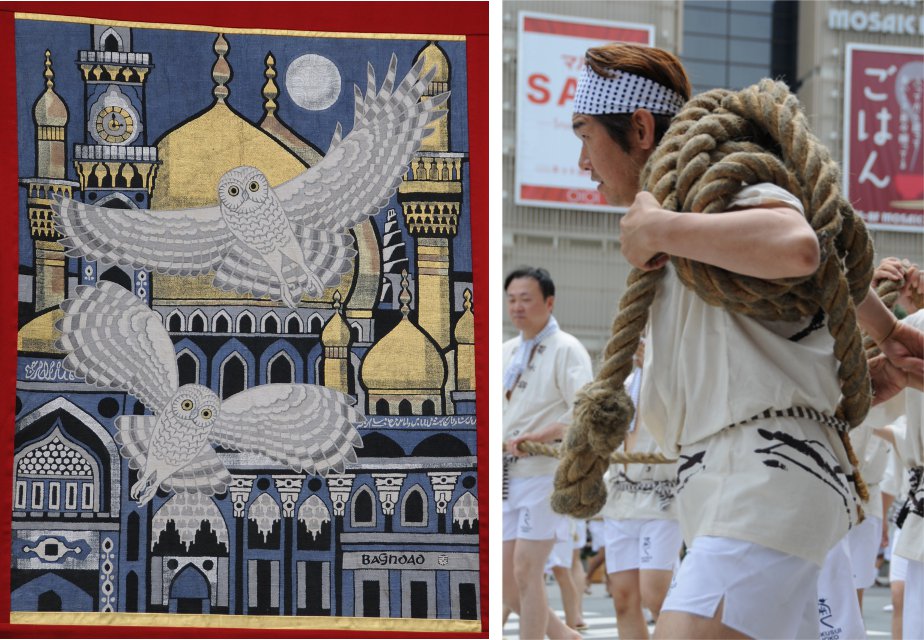
Anyway, back to the two types of floats: A yama is essentially an elevated platform on wheels, maybe four metres high. It is covered with tapestries and shows a well known scene from myth or real history on the platform. The almost life-sized wooden figures used for that are also exhibited during yoiyama, in fact, they are often placed at the centre of an altar and I have seen people placing offers in front of them and praying to them before they are moved onto the platforms. I am not entirely sure, but it seems that the figures used are really the originals, different than the tapestries.
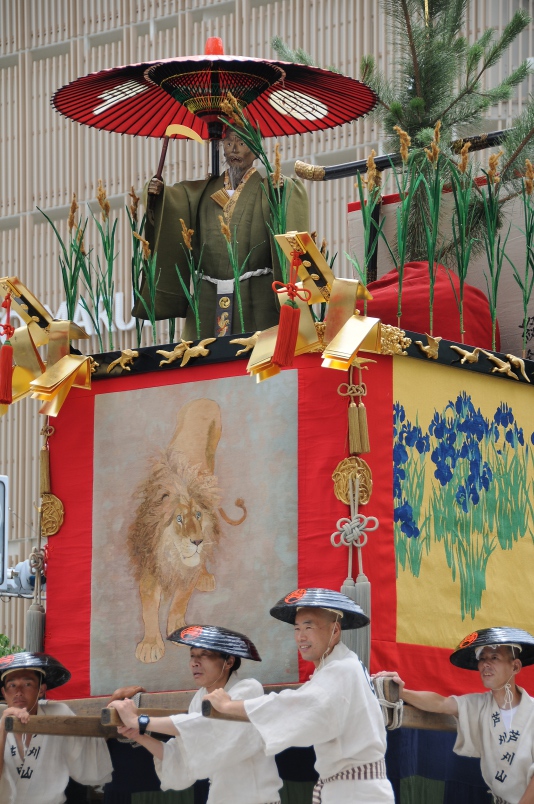
The second type of floats are the hoko. They are enormous things resembling mobile war towers, on man sized wheels, with a roofed platform on which musicians (drums, flutes, bells…) sit and play throughout the procession. On the roof sits a long wooden pole, making the hoko up to 25 metres high in total, and the pole is decorated with straw and paper in the lower part and bears a special type of tip which gives the hoko its name. A hoko can weigh more than ten tons and it is pulled by 40 – 50 men with two thick ropes fastened to the front. Some of the hoko carry wooden images together with the musicians, and all of them are hung with beautiful tapestries.
The procession starts at 9 am, goes along three main streets of the city centre, and has to make three 90 degree turns on the way. I was at the intersection where the first turn would take place at about 8 am, and luckily enough I could still find a spot in the front row – it was surprisingly crowded all the way. Police lined the already empty streets and and many of the shops in this otherwise busy shopping arcade were closed. The people waited patiently, until, as final act before the procession, the overhead traffic lights and signs were folded away. Soon after, you could hear the tune of the musicians, and the very first hoko came down Shijo dori and reached the intersection.
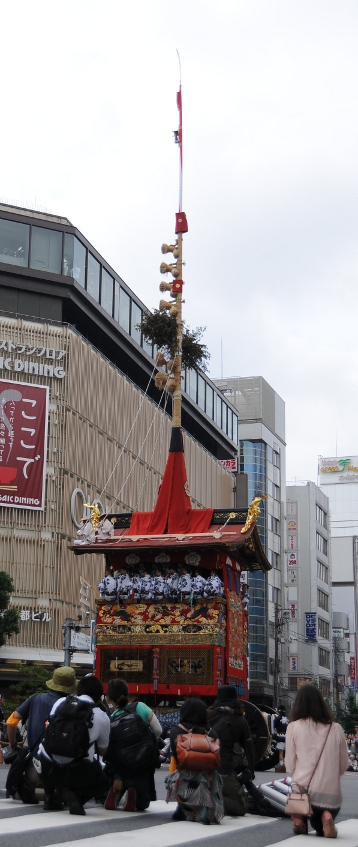
The procession is always headed by the naginata hoko, which has a Japanese halberd, a naginata, on top of its pole. It is the one that has the chigo on board, a child performing rituals from the hoko, to drive evil spirits away. He is chosen among the 10 year old boys of Kyoto’s best families and wears heavy white makeup, golden headgear, and an orange robe with long sleeves.
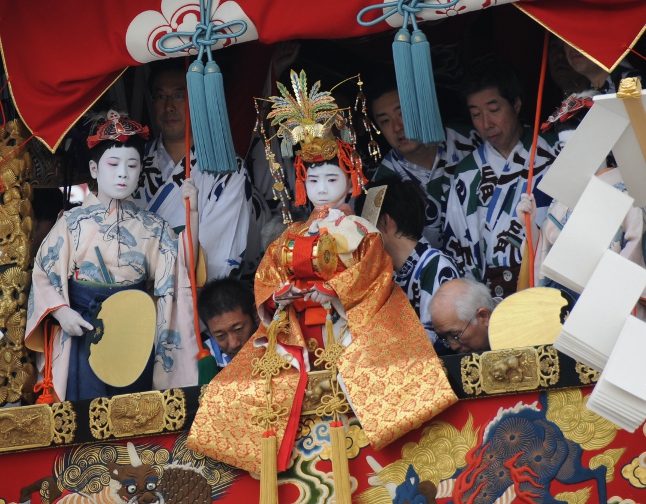
Recall that a hoko is a 10 ton affair pulled by 50 men. They can only go straight and cannot be steered. So, any large change of direction – as the 90 degrees necessary at any of the three curves of the route – is an interesting spectacle. First, the hoko’s front wheels are placed on bamboo poles, slit in half lengthwise, while the back wheels are held in place by large woodblocks. The men standing in the lower part of the hoko, close to the wheels, shout their commands, wave their fans, and then the hoko is pulled to the side in a swift effort. One hoko was turned with only two strong pulls, the others needed more, so the whole operation can take a while. In any case it was very exciting to watch every time, and the musicians on top never ceased to play or even missed a tone.
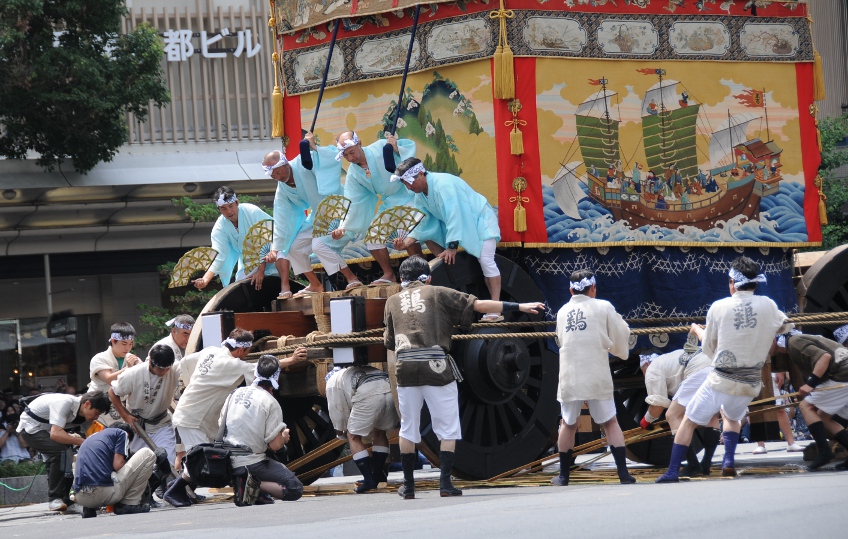
Turning a yama is less of an issue as they can be simply lifted off the ground, although some groups made an effort to show off their strength and made one, even two full turns with the yama – to the great satisfaction of the spectators!
After the naginata hoko come all the others in random order as drawn by lot on July 2nd. The whole procession of all 32 floats takes about three hours to pass any one point. There are many breaks in between though, clearly because of the time the turning of the hoko takes, which cannot be predicted. All in all I found the procession very interesting, but also very tiring, especially as my front row spot meant I had to sit on the hard street with folded knees all the time. I now understand why people bring little folding stools with them – even those who accompany the hoko on foot take a break to sit down during the turning.
In the evening, the second part of the festivities take place. All three mikoshi of Yasaka shrine – and with them their deities – are moved to their temporary residence at the Otabisho, located at the intersection of Shijo and Teramachi. Once again, young men dressed in white carry the mikoshi through the streets of Kyoto to their destination. There are three routes through town, and the atmosphere is light again, with lots of encouraging shouting by the carriers and spectators as well.
